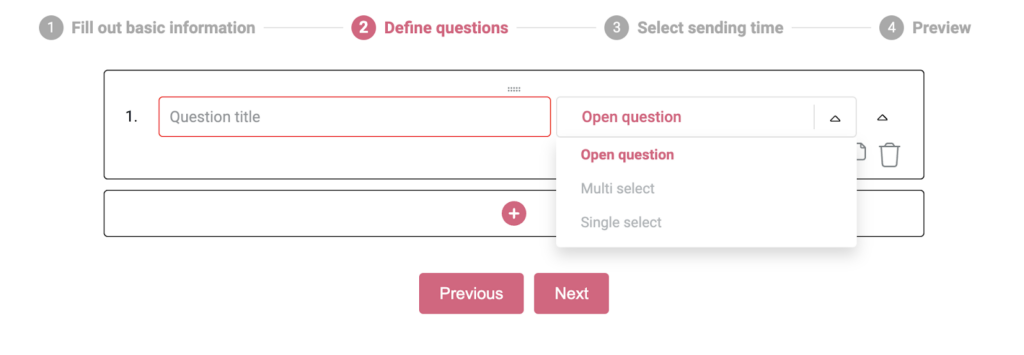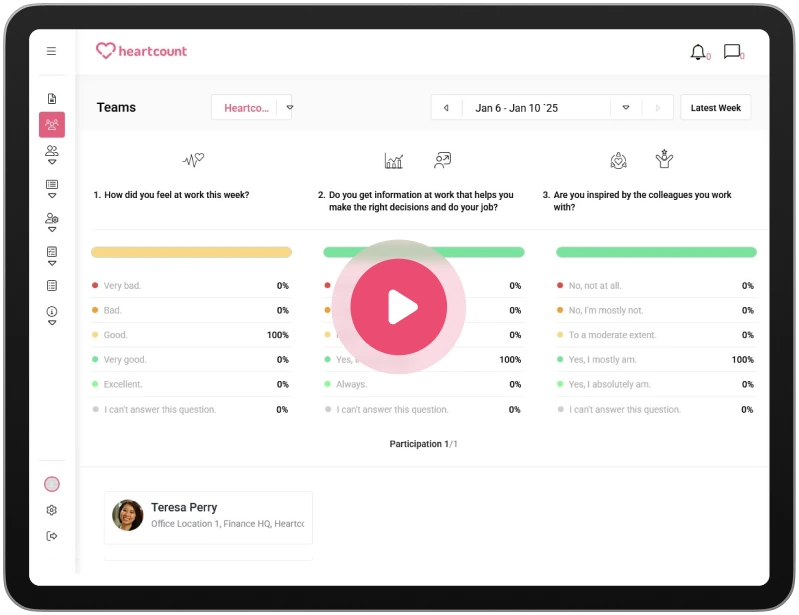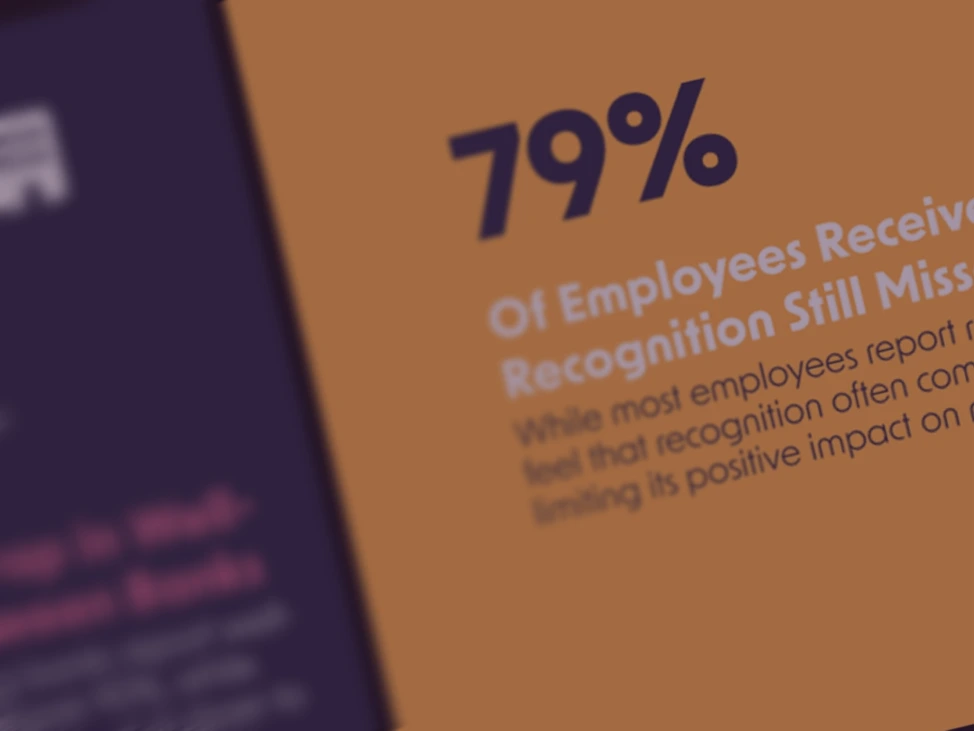Employee happiness survey: Check the pulse of your workforce

Imagine you have an enthusiastic employee who is always eager to take on new projects and whose energy inspires everyone around him – the kind of team member every organization dreams of having. But lately, something has changed. He has been arriving at work late, keeping to himself, and no longer participating in meetings like he used to. His work is slipping, and deadlines are often missed.
Does this scenario sound familiar? (Hope it doesn’t.)
If it does, it may indicate that your previously satisfied employee is now struggling with unhappiness. This shift can have a lasting impact on team performance and business outcomes. It’s not just individuals who suffer. Collaboration with coworkers becomes challenging, and even clients may sense something is off. What began as a personal issue is now affecting the entire company.
That’s why it’s important to regularly assess employee happiness and recognize the signs of discontent before they escalate.
-
1.How to recognize unhappy employees?
-
2.Why is it important to measure employee happiness?
-
3.How to measure employee happiness?
-
4.How to conduct an employee happiness survey?
-
5.15 employee happiness survey questions to ask your employees
-
6.Tips for improving employee happiness based on survey results
-
7.Employee happiness survey: Investment in your company’s future
-
8.Employee happiness survey FAQs
Imagine you have an enthusiastic employee who is always eager to take on new projects and whose energy inspires everyone around him – the kind of team member every organization dreams of having. But lately, something has changed. He has been arriving at work late, keeping to himself, and no longer participating in meetings like he used to. His work is slipping, and deadlines are often missed.
Does this scenario sound familiar? (Hope it doesn’t.)
If it does, it may indicate that your previously satisfied employee is now struggling with unhappiness. This shift can have a lasting impact on team performance and business outcomes. It’s not just individuals who suffer. Collaboration with coworkers becomes challenging, and even clients may sense something is off. What began as a personal issue is now affecting the entire company.
That’s why it’s important to regularly assess employee happiness and recognize the signs of discontent before they escalate.
How to recognize unhappy employees?
If you identify early signs that your employee is unhappy, you can address underlying issues before they escalate.
Key signs and symptoms to watch for:
- Decreased productivity: One of the most noticeable signs of employee dissatisfaction is a drop in productivity. An unhappy employee may miss deadlines, produce lower-quality work, or struggle to complete tasks efficiently. Decline in output can impact the entire team’s performance.
- Behavioural changes: A change in attitude or behaviour is another red flag. Employees who were once positive and engaged might become withdrawn, moody, or pessimistic. They may avoid social interactions, skip team meetings, or isolate themselves from colleagues.
- Lack of engagement: Disengaged employees often show a lack of enthusiasm for their work. They might participate less in meetings, avoid taking on new projects, or stop contributing ideas. Their disinterest can spread and affect overall team morale.
- Frequent absenteeism: Unhappy employees are more likely to have poor attendance records. They might frequently arrive late, leave early, or take more sick days. Their absenteeism can disrupt the workflow and place additional strain on their teammates.
- Negative attitude: A consistently negative attitude, including frequent complaints or resistance to change, strongly indicates dissatisfaction. Negativity can spread throughout the workplace and create a toxic environment that affects everyone.
- Reduced initiative and creativity: Unhappy employees tend to do only the bare minimum. They stop proposing new ideas, taking risks, or going beyond their basic job duties. This lack of creativity can stifle innovation within the organization.
- Social disconnection: A disengaged employee might withdraw from team activities and social interactions. They may avoid casual conversations, refuse to participate in team-building exercises, or decline invitations to social events, causing a breakdown in team cohesion.
Factors influencing workplace happiness
Several factors shape workplace happiness; understanding them can help create an environment where employees feel satisfied, motivated, and engaged:
1. Work environment
The physical space where employees work and the overall atmosphere affect their happiness. A comfortable, safe, and well-organized workspace helps people focus and feel good about coming to work.
Additionally, a positive social environment, where employees feel connected to and supported by their colleagues, can boost morale. Conversely, a stressful or negative environment can lead to dissatisfaction and burnout.
2. Management style
Employees are happier when managers are supportive, communicate well, and treat everyone fairly. A good management style encourages independence, sets clear expectations, and recognizes hard work.
However, micromanaging or poor communication can frustrate employees and lower job satisfaction. In fact, uncaring leaders are a top reason for quitting (35% of survey respondents mentioned it), along with low pay, no opportunities for career growth, and lack of meaningful work.
3. Job roles and responsibilities
When employees feel their work is important and aligns with their skills, they are more satisfied. If their tasks are boring or unclear, or if they see no chance for advancement, they might become unhappy and disengaged.
4. Work-life balance
Employees who have enough time for family, hobbies, and rest are usually more content and less stressed. Offer flexible hours or the ability to work from home to improve this balance and increase workplace happiness.
Flexibility in work location and hours is a key driver of job satisfaction. In a study, only 21.6% of full-time, in-office workers were happy with their work environment, compared to 28.3% of hybrid and 35.4% of remote workers
5. Recognition and rewards
Employees need to feel appreciated for their work. When they are recognized and rewarded for their efforts—whether through bonuses, promotions, or even just verbal praise—they are more likely to stay motivated and happy. On the other hand, a lack of recognition can make employees feel undervalued and unhappy.
According to Gallup, only about one in three U.S. workers strongly agree that they received praise or recognition for their work in the last week. Many employees feel their hard work goes unnoticed, and those who feel unappreciated are twice as likely to say they plan to quit within the next year.
6. Growth opportunities
A clear path to career advancement is important for employee satisfaction. When companies offer training, development programs, and chances to take on new challenges, employees feel more motivated and happy in their roles. Without these opportunities, employees may feel stuck and become disengaged.
Employee happiness vs. employee satisfaction
Employee happiness and employee satisfaction are different concepts that influence an employee’s experience.
Employee happiness is about the emotional state of an employee. It refers to how employees feel on a day-to-day basis while performing their jobs. It is related to the immediate work environment, relationships with colleagues, and the overall atmosphere in the workplace.
Happy employees tend to enjoy their work, feel positive about their tasks, and generally experience joy and fulfilment at work. This emotional aspect can fluctuate depending on daily experiences or interactions.
Employee satisfaction is a broader and more stable measure. It involves how content employees are with their jobs over time, including factors like pay, benefits, job security, and working conditions.
Satisfaction is about whether the job meets the employee’s needs and expectations. A satisfied employee may not always be happy, but they feel their job provides them with what they need to feel secure and valued in the long term.
Employee happiness vs. employee engagement
Employee happiness refers to how employees feel, while engagement is about how much they are involved and committed to their work.
A happy employee might enjoy their job but may not necessarily be highly engaged, while an engaged employee is not only happy but motivated to perform well, contribute ideas, and go the extra mile.
They are deeply connected to their work, understand how their role impacts the company’s goals, and are actively involved in helping the organization succeed.
Why is it important to measure employee happiness?
Measuring employee happiness is important for several reasons, and all of them contribute to the overall success of an organization.
As Gareth Callaway, President of Gateway Staffing, states:
“Employee happiness. It’s a bit of a knitting circle topic, isn’t it? Because who cares? Just do your stinking job and stop complaining. Except it’s not. Employee happiness has a direct impact on what you do care about: profitability, productivity, employee engagement (sorry, engagement sounds a bit knitting circle-ish), employee retention, employee churn.”
Let’s see how employee happiness adds to your company’s success:
1. Boosting productivity
Employees with positive sentiment about their work are more motivated, focused, and efficient in their tasks. This increases productivity, as they are more likely to go above and beyond in their roles.
Happy workers are 12% more productive than their less happy colleagues, which leads to better performance and workplace success, as employees who are content are.
2. Enhancing morale
Employee happiness directly impacts morale, which is the overall outlook, attitude, and satisfaction employees feel at work.
High morale creates a positive and supportive workplace where employees collaborate and support each other. This collective positivity can improve the overall atmosphere of the workplace, making it more enjoyable and less stressful for everyone.
3. Reducing turnover
When employees are happy, they are less likely to leave their jobs.
High employee happiness reduces turnover rates, saving companies the significant amounts of money needed for recruiting, hiring, and training new staff.
A stable workforce also means retaining valuable institutional knowledge and maintaining consistency in work processes.
4. Improving customer satisfaction
Happy employees often provide better service to customers. When employees feel good about their work, they are more likely to engage positively with clients, providing better service, which can lead to higher customer satisfaction and loyalty.
5. Fostering innovation
Employees who are happy and feel valued are more likely to be creative and innovative.
They are more inclined to share ideas and take initiative, which can drive the company forward and lead to new opportunities for growth.
How to measure employee happiness?
Measuring employee happiness helps companies understand how their workers feel about their jobs and the workplace. This is important for improving satisfaction and making the company a better place to work.
Different ways to gather this information include surveys, feedback forms, and tracking workplace behaviours like absenteeism. Each method gives useful insights to see what’s working and what needs to be improved to keep employees happy and engaged.
- Employee surveys: These questionnaires gather insights about employees’ overall satisfaction, work environment, and happiness. Pulse surveys are short, frequent check-ins, while annual satisfaction surveys provide a deeper, broader look once a year.
- One-on-one interviews: Direct, personal interviews between happiness consultants or HR professionals and employees provide detailed, qualitative insights into individual employee experiences, challenges, and satisfaction levels.
- Focus groups: Small group discussions involving employees from different departments or teams, where participants discuss workplace experiences, allowing companies to uncover trends and collective sentiments.
- 360-degree feedback: This method collects feedback on an employee’s performance from their peers, subordinates, and managers. It not only helps assess individual happiness but also reveals organizational culture and team dynamics.
- Feedback forms: These are open-ended forms where employees can provide comments and suggestions. They offer a simple way for employees to voice concerns or praise anonymously or openly.
- Anonymous suggestion boxes: Employees can anonymously submit ideas, concerns, or feedback about the workplace. Anonymity allows them to express their genuine feelings without fear of judgment or repercussions.
- Employee Net Promoter Score (eNPS): eNPS measures how likely employees would recommend their workplace to others, offering a simple way to assess overall employee loyalty and happiness on a scale of 0-10.
- Employee check-ins/performance reviews: Regularly scheduled meetings between employees and their supervisors offer an opportunity to discuss job satisfaction, career goals, and overall happiness in the role.
- Absenteeism and turnover rate tracking: High absenteeism or turnover rates can signal dissatisfaction or unhappiness in the workplace. Tracking these rates provides indirect but valuable insights into employee well-being.
- Social listening tools: These tools analyze employee discussions on internal communication platforms (e.g., Slack, Microsoft Teams) to identify mood, concerns, and sentiment trends within the organization.
With HeartCount, you can effortlessly gauge your team’s pulse through automatic weekly or biweekly surveys that take just a few seconds to complete. This tool helps HR managers stay connected with the team and address issues promptly.

With HeartCount, you can measure employee eNPS through regular pulse surveys or by creating custom surveys. This approach delivers valuable insights into whether employees would recommend the organization as a great place to work and provides precise information about their future intentions and loyalty.

Understanding employee happiness metrics
You can use various metrics and indicators to get insights into how employees feel about their work environment, relationships, and overall job satisfaction.
Here’s a breakdown of each:
- Employee satisfaction score: A score based on survey questions about how satisfied employees feel with their job. Higher scores mean employees are more satisfied and likely happier at work.
- eNPS: A metric that asks employees how likely they are to recommend the company as a good place to work on a scale from 0 to 10. Responses are categorized into Promoters (9-10), Passives (7-8), and Detractors (0-6). A higher eNPS means more employees are likely to promote the company, which reflects higher morale and loyalty.
- Absenteeism rate: The rate at which employees are absent from work, often measured in terms of unplanned absences. A high absenteeism rate may indicate poor job satisfaction, work-life balance issues, or workplace stress.
- Turnover rate: The percentage of employees leaving the company within a specific time frame. A high turnover rate is a red flag for low job satisfaction or cultural misalignment, while a low rate suggests a happier, more stable workforce.
- Employee Satisfaction Index (ESI): A broader measure that takes into account different aspects of the job, like compensation, work environment, and opportunities for growth. A higher ESI means employees are generally happy in multiple areas of their job.
- Engagement levels: Measures how emotionally invested and motivated employees are in their work. It can be assessed through surveys and participation in company initiatives. High engagement levels indicate happiness – strong emotional connections with the company, and higher productivity.
- Productivity metrics: These measure how well employees are performing their tasks or meeting their goals. Happy employees tend to be more productive, so increasing productivity can indicate rising employee satisfaction.
What is an employee happiness index?
An employee happiness index is a metric used to measure and track how satisfied and content their employees feel in the workplace.
It involves gathering data, typically through surveys, on various aspects of the job, such as:
- Working conditions
- Compensation
- Job security
- Career growth opportunities
- Relationships with coworkers
The index can be calculated using various methodologies but generally involves assigning numerical values to different aspects of employee happiness and then combining these values to create an overall “happiness score”. A higher score indicates greater employee happiness and satisfaction.
This data-driven approach allows companies to pinpoint specific issues that may be negatively affecting employee well-being, such as high stress levels or lack of recognition, and make the necessary adjustments.
How to conduct an employee happiness survey?
By following these steps, you can effectively conduct employee happiness surveys and use the insights to create a better work environment:
1. Set clear goals
Before you start designing the survey, decide exactly what you want to learn from it. Do you want to measure overall employee happiness or focus on specific areas like work-life balance, employee engagement, or job satisfaction?
Clear goals help you focus on what questions to ask. For example, if you want to know about work-life balance, you can ask questions about employees’ satisfaction with their schedules and workload. By having clear objectives, you can target the right issues and avoid unnecessary questions.
2. Design the survey
Once your goals are set, design the survey to cover the key areas you identified. Use a combination of question types to gather different kinds of information:
- Multiple-choice questions for easily measurable data (e.g., “On a scale of 1 to 5, how happy are you with your job?”)
- Open-ended questions to get more personal feedback (e.g., “What improvements would make your work experience better?”).
This mix allows you to collect both numbers you can analyze and specific comments that reveal deeper insights into employee concerns.
3. Ensure anonymity
It’s important that employees feel safe when sharing their true thoughts. Let them know their responses will remain anonymous.
Anonymity encourages employees to be honest without worrying about negative consequences. If employees don’t feel safe, they might withhold important feedback, which could prevent you from identifying serious problems in the workplace.
Use a trusted platform like HeartCount that guarantees privacy and provides both anonymous and confidential options for replies.
4. Pilot the survey
Before sending the survey to all employees, test it with a small group. This step helps you check if any of the questions are confusing or if there are any technical issues with the survey tool.
For example, some questions may need clearer wording, or the survey might be too long and cause participants to rush through it. The pilot test helps ensure the survey works smoothly and collects meaningful data.
5. Distribute the survey
Once everything is ready, send out the survey to the entire workforce. With HeartCount, your employees will get questions directly through email, and they can respond in under 15 seconds. You will see real-time answers and get notifications about people you should keep your eye on.
Make sure to provide clear instructions and a deadline for completing the survey. Sending reminders can also help increase participation. The easier it is for employees to take the survey, the more likely they are to complete it.
6. Collect and analyze data
After employees have filled out the survey, the next step is to analyze the results.
Look for patterns in the responses. For example, are there certain departments where satisfaction is low? Do multiple employees mention the same issues, like poor communication or lack of recognition?
Use these trends to identify what areas need the most attention. Analyzing both the numerical data and the open-ended responses gives you a complete picture of employee happiness.
Track semiannual reports that summarize all the stats and scores for every area you’ve been surveying about employee experiences. These reports also give you a detailed view of each question sent to employees during that time.
7. Communicate the results
Share the results of the survey with all employees. Be transparent about what you learned, both the positives and the areas for improvement.
For example, if the survey shows that many employees are happy with the company’s work-life balance but feel underappreciated, acknowledge both of these points.
Let employees know that their feedback is being taken seriously and that action will be taken. Clear communication helps build trust and shows that the survey wasn’t just a formality.
8. Develop an action plan
Now that you have the data, it’s time to create a plan to address the issues that were raised. For example, if employees expressed a need for better recognition, you might set up a formal employee recognition program. If work-life balance is a concern, consider offering more flexible work schedules.
The plan should include specific steps, a timeline, and employees who will be responsible for implementing the changes. Without a clear action plan, the survey won’t lead to real improvements.
9. Follow up and monitor progress
The survey is not a one-time event. After implementing the changes, follow up with employees to see if the improvements are making a difference. This can be done through smaller, more frequent pulse surveys that measure employee happiness regularly.
Monitoring progress over time will ensure that the actions you took are effective, and if they’re not, you can adjust your approach as needed
15 employee happiness survey questions to ask your employees
Include the following questions in the employee happiness survey to gather comprehensive feedback on various aspects of work life, employee satisfaction, and overall well-being:
- How satisfied are you with your current role? This measures general job satisfaction, providing a quick snapshot of employee happiness.
- Do you feel valued and appreciated in your role? Feeling appreciated is crucial for motivation and engagement.
- How would you rate your work-life balance? Understanding how employees manage their work and personal lives helps gauge overall well-being.
- Do you feel your skills and strengths are fully utilized? Employees are happier when they can use their talents effectively.
- Are you content with the opportunities for professional growth and development? Career advancement opportunities are important for long-term retention.
- How well does your manager communicate expectations and provide feedback? Effective communication from supervisors ensures clarity and boosts employee morale.
- Do you feel supported by your colleagues and team members? Team support enhances job satisfaction and improves the workplace environment.
- Are you happy with your compensation and benefits package? Compensation satisfaction directly influences motivation and retention.
- Do you feel comfortable sharing your ideas and opinions at work?
An open environment for sharing ideas fosters innovation and inclusivity. - How satisfied are you with the company’s diversity and inclusion efforts? A diverse and inclusive work environment is key to employee satisfaction.
- How would you rate the level of recognition you receive for your work? Recognition is critical for motivation and morale.
- Do you feel that your workload is manageable? Managing workloads effectively can prevent burnout and increase job satisfaction.
- Do you have opportunities to learn and grow in your role? Employees value the chance to improve their skills and advance their careers.
- How well do you understand the company’s goals and how your work contributes to them? A sense of purpose aligns personal goals with the company’s mission, enhancing job satisfaction.
- How likely would you recommend working at this company to a friend or colleague? This question helps gauge overall satisfaction and loyalty, similar to an eNPS.
Tips for improving employee happiness based on survey results
After conducting employee surveys, the real challenge is to take action based on the feedback received. Following practical steps can help you address key issues identified in surveys and create a positive workplace culture that increases employee satisfaction and overall company performance.
1. Identify key problems
After collecting survey responses, take time to find out which issues come up the most. For example, if many employees mention stress from too much work, lack of communication, or feeling underappreciated, these are your top problems to address. Use data to prioritize what’s most important.
Solving the biggest problems first shows employees that you take their feedback seriously. It also helps create quick, visible improvements that impact overall happiness.
Start with small, achievable goals for improvement. For instance, if workload is a big issue, begin by adjusting task distribution or hiring additional staff.
2. Be open about the results and the plan
Once you’ve reviewed the survey results, share them with all employees. Be honest about the issues and explain what steps you plan to take to address them. Provide regular updates so employees know you’re making progress.
When companies are open and transparent about their actions, they build trust. When employees see that you act on their feedback, they are more likely to participate in future surveys and stay engaged.
Hold a company-wide meeting to discuss the survey results or send out an email with the key findings. Outline a timeline for addressing the major issues and update employees regularly.
3. Involve employees in fixing problems
Allow employees to contribute ideas on what would make their work experience better. You can do this by forming focus groups or holding meetings where employees share ideas on how to fix the issues identified in the survey.
When employees help shape the solutions, they feel more invested in making those changes work. Plus, employees often have a better understanding of what will work in their specific roles.
Assign a small team of volunteers to focus on each major issue. Let them suggest changes, like improving team communication or making workloads more manageable.
4. Improve opportunities for career growth
If employees feel they don’t have enough room to grow, offer more career development opportunities. This could include providing additional training, mentorship programs, or clear promotion paths. Make sure employees know what they need to do to advance in their roles.
People are more likely to stay with a company if they feel like they’re growing and advancing. When employees see a future for themselves at the company, they feel more motivated and engaged.
Create a career development plan for each employee or offer regular training sessions to help employees build new skills. Encourage managers to discuss career goals with their team members during one-on-one meetings.
5. Support better work-life balance
If your survey shows that employees are stressed or overwhelmed, consider offering more flexible work arrangements. Provide employees with options, such as working from home, having flexible hours, or additional paid time off.
Begin by asking employees what would help them manage their work-life balance. You might offer options like flexible work schedules or provide resources like mental health days or wellness programs.
A healthy balance between work and personal life is key to long-term happiness. Employees who can better manage their time are more productive and less likely to experience burnout.
6. Recognize employee efforts
Set up programs that allow for regular recognition of employees’ hard work. This could be through monthly awards, public shout-outs in team meetings, or peer recognition programs where employees can acknowledge each other’s contributions.
Everyone wants to feel appreciated. Regular recognition improves employee morale and makes people feel valued. This simple step can boost happiness and motivation.
Introduce a formal recognition program where employees can nominate coworkers for awards or shout-outs. Dedicate time in team meetings to acknowledge accomplishments and celebrate wins, both big and small.
7. Follow up with more surveys
Don’t stop after one survey. Regularly check in with employees using short pulse surveys. These are quick surveys that help track whether the changes you’ve made are actually improving employee happiness. Make sure you’re asking the same key questions to see if there’s been progress.
Continuous feedback shows that the company is committed to long-term improvements, not just quick fixes. It also helps track progress over time and make adjustments where needed.
Schedule bi-weekly pulse checks to measure employee happiness.
HeartCount allows you to send three questions every week that explore eight key categories and three dimensions of engagement at work during the entire year. You can also opt for custom surveys that can contain between one and 50 questions. Surveys are built from a set of 140 scientifically validated questions, ensuring compliance with Gallup’s Q12 Employee Engagement Survey.
Compare the new results with previous surveys to see what’s improved and what still needs work. You can analyze and interpret responses with data-rich KPI dashboards and advanced proprietary measurement indices.
Employee happiness survey: Investment in your company’s future
Employee happiness directly impacts employee productivity, motivation, and engagement, which affects the quality of their work and how satisfied customers are. When employees are happy, they tend to be more innovative, creative, and dedicated to their jobs, leading to positive outcomes across the organization.
By regularly conducting employee happiness surveys, companies can gain important insights into how employees feel about the workplace. This feedback helps identify problems, track improvements, and support long-term success.
Focusing on employee happiness is an investment in the company’s future. Take the first step today—start a free trial with HeartCount, the ultimate tool for real-time insights into employee happiness.
Employee happiness survey FAQs
1. Why measure employee happiness?
Measuring employee happiness helps companies understand how satisfied their workers are, which can lead to higher productivity, better retention, and improved workplace culture. Happy employees are more engaged and motivated.
2. How do you measure something as complex as happiness?
Measuring happiness is complex because it involves both emotions and practical aspects of the job. Companies use various methods to assess it: surveys, feedback forms, interviews, and tracking indicators like absenteeism and turnover. These tactics gather data on various aspects of job satisfaction, allowing companies to evaluate overall employee well-being.
3. What is an employee happiness survey?
An employee happiness survey is a questionnaire companies use to collect employee feedback on job satisfaction, work environment, and overall well-being. It helps companies identify areas for improvement to boost employee morale and happiness.
4. What are the five factors of employee happiness?
The five key factors of employee happiness typically include:
- Meaningful work
- Recognition
- Work-life balance
- Career development opportunities
- Supportive work relationships
HeartCount helps you spot and address shifts in employee happiness early, fostering a supportive environment where your team – and business – can thrive. Stay connected and keep your workplace thriving with HeartCount. Want to learn how?








